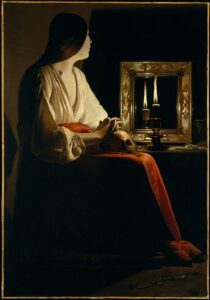Discussion Group 6 May on The Limits of Authenticity: Remaking with Hazardous Materials

Georges de la Tour, The Penitent Magdalen, c. 1640. 133.4 x 102.2 cm. Oil on canvas, New York, Metropolitan Museum.
One cliché about Renaissance make up is that it was generally made of materials that were either poisonous (eg mercury, lead, arsenic) or unpalatable (eg bird droppings, human urine, bats’ blood). This fed into a wide range of artistic and literary tropes that linked beauty to vanity and to death, as in George de la Tour’s painting on the left, of a youthful Mary Magdalen seated next a mirror, cradling a skull on her lap.
Although much Renaissance skincare and hygiene products are based on sweet-smelling herbs and flowers in a medium such as vegetable oil, water, alcohol or wax-based cream – there are several recipes that contain the ingredients noted above. Poisonous minerals were particularly associated with skin-whitening.
If historical remakers are to thoroughly investigate premodern cosmetic and medicinal recipes therefore, we need to think about what we lose if we cannot engage with these difficult materials. If human subjects are in any way involved, safety is paramount, so in the classes and workshops we have run since our first foray into remaking renaissance make up in 2011, skin-whitening ingredients like lead white have been swapped with materials that are known to be safe on the skin, such as titanium dioxide, a frequent ingredient in sunscreen.
This is hardly authentic, however. It does not tell us at all accurately what renaissance make up looked like, or what it felt like to apply or wear. So how do we tackle the competing claims of authenticity and safety? As well as a general discussion that considers the issues of danger and authenticity in a variety of remaking projects, we will hear from Dr Fiona McNeil (McMaster University), about the ‘Toxic Allure’ project, which investigates the effects of white lead make up on early modern women from the safety of a specialist lab.
If you would like to join this discussion, please email renaissancegooproject@gmail.com, or get in touch with us via Twitter @RenaissanceGoo



